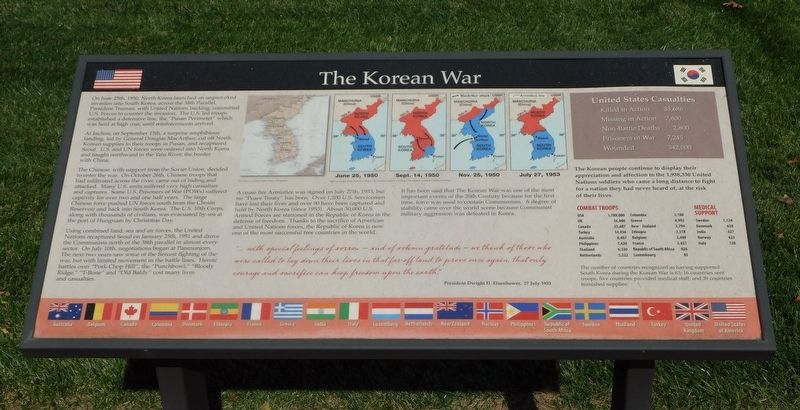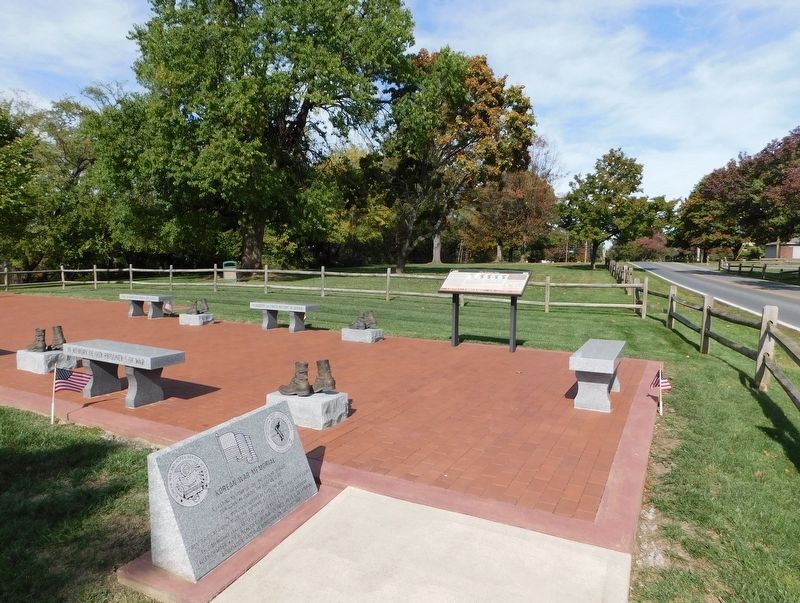Winchester, Virginia — The American South (Mid-Atlantic)
The Korean War
On June 25th, 1950, North Korea launched an unprovoked invasion into South Korea, across the 38th Parallel. President Truman, with United Nations backing, committed U.S. Forces to counter the invasion. The U.S. led troops established a defensive line, the "Pusan Perimeter" which was held at high cost, until reinforcements arrived.
At Inchon, on September 15th, a surprise amphibious landing, led by General Douglas MacArthur, cut off North Korean supplies to their troops in Pusan, and recaptured Seoul. U.S. and UN forces were ordered into North Korea and fought northward to the Yalu River, the border with China.
The Chinese, with support from the Soviet Union, decided to enter the war. On October 26th, Chinese troops that had infiltrated across the river, came out of hiding and attacked. Many U.S. units suffered very high casualties and captures. Some U.S. Prisoners of War (POWs) suffered captivity for over two and one half years. The large Chinese force pushed UN forces south from the Chosin Reservoir and back into South Korea. The U.S. 10th Corps, along with thousands of civilians, was evacuated by sea at the port of Hungnam by Christmas Day.
Using combined land, sea and air forces, the United Nations recaptured Seoul on January 25th, 1951 and drove the Communists north of the 38th parallel in almost every sector. On July 10th, negotiations began at Panmunjom. The next two years saw some of the fiercest fighting of the war, but with limited movement in the battle lines. Heroic battles over "Pork Chop Hill", the "Punchbowl," "Bloody Ridge," "T-Bone" and "Old Baldy" cost many lives and casualties.
A cease fire Armistice was signed on July 27th, 1953, but no "Peace Treaty" has been. Over 1,200 U.S. Servicemen have lost their lives and over 90 have been captured and held by North Korea (since 1953). About 30,000 U.S. Armed Forces are stationed in the Republic of Korea in the defense of freedom. Thanks to the sacrifice of American and United Nations forces, the Republic of Korea is now one of the most successful free countries in the world.
It has been said that The Korean War was one of the most important events of the 20th Century because for the first time, force was used to contain Communism. A degree of stability came over the world scene because Communist military aggression was defeated in Korea.
"... with special feelings of sorrow - and of solemn gratitude - we think of those who were called to lay down their lives in that far-off land to prove once again, that only courage and sacrifice can keep freedom upon the earth."
President Dwight D. Eisenhower, 27 July 1953
Killed in Action 33,686
Missing in Action 7,600
Non-Battle Deaths 2,800
Prisoners of War 7,245
Wounded 342,000
The Korean people continue to display their appreciation and affection to the 1,938,330 United Nations soldiers who came a long distance to fight for a nation they had never heard of, at the risk of their lives.
COMBAT TROOPS
USA 1,789,000
UK 56,000
Canada 25,687
Turkey 14,936
Australia 8,407
Philippines 7,420
Thailand 6,326
Netherlands 5,322
Columbia 5,100
Greece 4,992
New Zealand 3,794
Ethiopia 3,518
Belgium 3,498
France 3,421
Republic of South Africa 826
Luxembourg 83
MEDICAL SUPPORT
Sweden 1,124
Denmark 630
India 627
Norway 623
Italy 128
The number of countries recognized as having supported South Korea during the Korean War is 63; 16 countries sent troops, five countries provided medical staff; and 39 countries furnished supplies.
Topics. This historical marker is listed in this topic list: War, Korean. A significant historical date for this entry is January 25, 1951.
Location. 39° 10.617′ N, 78° 9.229′ W. Marker is in Winchester, Virginia. Marker is on Maple Drive, 0.1 miles south of East Cork Street (Virginia Route 657), on the right when traveling south. Marker is located in Jim Barnett Park. Touch for map. Marker is at or near this postal address: 1001 Maple Drive, Winchester VA 22601, United States of America. Touch for directions.
Other nearby markers. At least 8 other markers are within walking distance of this marker. Korean War Memorial (a few steps from this marker); POW-MIA (within shouting distance of this marker); Spottswood Poles (about 600 feet away, measured in a direct line); Veterans Memorial (approx. 0.3 miles away); Revolutionary War Patriots (approx. 0.3 miles away); War of 1812 Veterans (approx. 0.3 miles away); Mississippi (approx. 0.4 miles away); Alabama (approx. 0.4 miles away). Touch for a list and map of all markers in Winchester.
Credits. This page was last revised on November 5, 2023. It was originally submitted on November 5, 2023, by Bradley Owen of Morgantown, West Virginia. This page has been viewed 44 times since then and 14 times this year. Photos: 1, 2. submitted on November 5, 2023, by Bradley Owen of Morgantown, West Virginia.

